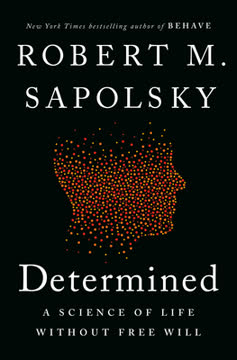Key Takeaways
1. Biology Shapes Behavior More Than We Realize
"No biology. No environment. Just the interaction between the two."
Complex Biological Interactions. Sapolsky argues that human behavior cannot be simplified into nature versus nurture categories. Our biological predispositions interact dynamically with environmental factors, creating complex behavioral outcomes that cannot be reduced to singular explanations.
Biological Nuance. Biological traits are not deterministic but represent potential pathways influenced by numerous factors. For instance, genetic tendencies create predispositions, not guaranteed outcomes:
- Genes provide potential behavioral ranges
- Environmental interactions shape actual expressions
- Individual experiences modify genetic predispositions
Holistic Understanding. Understanding human behavior requires recognizing the intricate dance between biological potential and environmental context. No single factor exclusively determines behavior, making simplistic explanations inadequate for comprehending human complexity.
2. Testosterone Doesn't Automatically Cause Aggression
"Testosterone isn't causing aggression, it's exaggerating the aggression that's already there."
Hormonal Complexity. Contrary to popular belief, testosterone doesn't directly cause aggression but amplifies existing behavioral patterns. The hormone acts more like an enhancer of predisposed tendencies rather than a trigger for violent behavior.
Nuanced Hormone Interactions:
- Normal testosterone levels are prerequisite for typical aggression
- Small fluctuations don't significantly alter aggressive behavior
- Large hormone variations can exaggerate existing behavioral patterns
Contextual Behavior. Aggression emerges from complex social and psychological interactions, not simply from hormonal levels. Understanding human behavior requires examining broader environmental and individual psychological contexts.
3. Adolescent Risk-Taking Drives Species Evolution
"Part of the reason for the evolutionary success of primates, human or otherwise, is that we are a pretty smart collection of animals."
Evolutionary Adaptation. Adolescent risk-taking and curiosity serve crucial evolutionary functions across primate species. The willingness to explore and transfer between social groups prevents inbreeding and facilitates genetic diversity.
Risk-Taking Benefits:
- Promotes genetic mixing
- Enables exploration of new territories
- Encourages innovative problem-solving
- Supports species adaptability
Biological Imperative. The drive for novelty and risk appears hardwired into primate developmental processes, suggesting that seemingly reckless behaviors actually represent sophisticated survival strategies.
4. Stress and Social Environment Impact Health Profoundly
"How successfully an individual ages also reflects how you live your daily life, long before reaching the threshold of old age."
Holistic Health Perspective. Individual health outcomes result from complex interactions between biological predispositions, social experiences, and personal lifestyle choices. Stress management and social connections significantly influence physiological functioning.
Stress Impact Factors:
- Social support networks
- Psychological coping mechanisms
- Individual personality traits
- Environmental challenges
Adaptive Responses. Bodies develop sophisticated responses to environmental challenges, demonstrating remarkable plasticity in managing stress and maintaining functional equilibrium.
5. Our Bodies Respond Strategically to Illness
"Your body is working in a very complex and specific way to make sure you feel awful and waste away when you are sick."
Adaptive Immune Responses. Seemingly unpleasant illness symptoms represent strategic biological mechanisms designed to fight infections and conserve energy. Fever, fatigue, and reduced appetite are not random experiences but intentional physiological strategies.
Illness Response Mechanisms:
- Fever increases immune system efficiency
- Reduced activity conserves energy for healing
- Metabolic changes support immune function
- Pain sensitivity helps prevent further injury
Biological Intelligence. The human body demonstrates remarkable complexity in responding to threats, with symptoms serving specific protective and adaptive purposes.
6. Partial Westernization Creates Unique Health Challenges
"You don't want a Western lifestyle until, along with your Westernized physiology, you have Westernized techniques of stress management as well."
Cultural Adaptation Complexities. Adopting Western lifestyle elements without corresponding psychological and physiological adaptations can create significant health challenges in developing societies.
Transition Difficulties:
- Metabolic system misalignments
- Stress management inadequacies
- Nutritional transition complications
- Cultural identity disruptions
Holistic Transformation. Successful cultural adaptation requires comprehensive changes across physiological, psychological, and social domains.
7. Religious and Psychological Experiences Share Deeper Connections
"Shamanism is a highly rewarded state."
Neuropsychological Foundations. Religious experiences and psychological phenomena potentially share underlying neurological mechanisms, suggesting deeper connections between spiritual practices and mental health.
Cognitive Parallels:
- Altered perception states
- Metamagical thinking patterns
- Evolutionary adaptive functions
- Neurological similarities
Cultural Evolution. Religious practices might represent sophisticated evolutionary adaptations for managing collective social experiences and individual psychological challenges.
8. Mental Disorders Might Have Evolutionary Advantages
"Having the occasional cousin who is schizophrenic is the evolutionary tolerable price of having a ready supply of schizotypals."
Genetic Complexity. Some mental disorders might represent evolutionary adaptations with potential survival advantages in specific contexts, challenging traditional pathological perspectives.
Adaptive Potential:
- Genetic trait variations
- Specialized social roles
- Cognitive diversity benefits
- Unique problem-solving approaches
Evolutionary Perspectives. Mental differences could represent biological strategies for maintaining group adaptability and innovation.
9. Cultural Differences Profoundly Influence Perception
"When science brings us something new and startling, there is often talk about us acquiring godlike knowledge."
Contextual Understanding. Cultural frameworks fundamentally shape human perception, interpretation, and experience of biological and psychological phenomena.
Perception Influencers:
- Social structures
- Historical contexts
- Linguistic frameworks
- Technological developments
Relativistic Worldview. Scientific understanding requires recognizing the profound impact of cultural perspectives on knowledge construction.
10. Individual Adaptability Determines Survival
"We are a fine species with some potential."
Dynamic Survival Strategies. Human survival depends on continuous adaptation, leveraging biological potential through flexible responses to changing environments.
Adaptability Components:
- Neurological plasticity
- Social learning capacities
- Technological innovation
- Cognitive flexibility
Evolutionary Potential. Human potential emerges from our capacity to transform challenges into opportunities through creative problem-solving.
Last updated:
FAQ
What's The Trouble with Testosterone about?
- Exploration of Human Behavior: The book examines the biological foundations of human behavior, focusing on hormones like testosterone and their influence on aggression and social dynamics.
- Collection of Essays: It features essays on diverse topics, including stress biology, primate social hierarchies, and the societal implications of behavioral biology.
- Nature and Nurture Interplay: Sapolsky explores the complex relationship between genetics and environment, challenging the simplistic nature versus nurture dichotomy.
Why should I read The Trouble with Testosterone?
- Accessible Science: Sapolsky presents complex scientific ideas in an engaging and understandable way, appealing to both lay readers and those with a scientific background.
- Insightful Perspectives: The essays offer thought-provoking insights into human behavior and mental health, encouraging readers to reflect on their own experiences.
- Interdisciplinary Approach: The book combines psychology, biology, and sociology, providing a holistic view of the human condition.
What are the key takeaways of The Trouble with Testosterone?
- Hormonal Influence on Behavior: Hormones like testosterone significantly influence aggression, but social context is crucial.
- Complexity of Human Nature: Human behavior is shaped by genetics, environment, and individual experiences, making it a complex interplay.
- Empathy and Understanding: Sapolsky advocates for compassionate understanding of behaviors, especially in mental health contexts.
What are the best quotes from The Trouble with Testosterone and what do they mean?
- "It's not him. It's his disease.": Highlights the importance of distinguishing between actions and underlying conditions, promoting empathy.
- "There is a danger of a certain empathy creep.": Warns that understanding someone's struggles can blur moral responsibility, balancing compassion with accountability.
- "The dichotomy is a sham.": Critiques the simplistic separation of nature and nurture, emphasizing their intricate interaction.
How does Robert M. Sapolsky define the relationship between testosterone and aggression in The Trouble with Testosterone?
- Testosterone as a Permissive Factor: Testosterone amplifies pre-existing tendencies in the right social context, rather than directly causing aggression.
- Castration Studies: Studies show castration reduces aggression, but reinstating testosterone doesn't always restore previous aggression levels, indicating complexity.
- Environmental Triggers: Aggression is context-dependent, with testosterone enhancing responses to environmental triggers.
What role does social hierarchy play in the behavior of baboons, according to The Trouble with Testosterone?
- Dominance and Aggression: Social hierarchies influence aggressive interactions, with higher-ranking baboons exerting control over lower-ranking ones.
- Stress and Health: Social stressors related to rank affect health and well-being, linking social dynamics to physiological responses.
- Behavioral Observations: Sapolsky's research provides detailed observations of baboon behavior, showing the impact of social structures on stress levels.
How does The Trouble with Testosterone address the concept of repressive personalities?
- Definition of Repressive Personalities: Repressors maintain tight emotional control, preferring structured environments, often at a physiological cost.
- Physiological Consequences: Repressors may have elevated stress hormone levels despite low reported anxiety, showing a disconnect between emotional and physiological states.
- Coping Mechanisms: Their coping strategies can lead to chronic stress, challenging the notion that emotional suppression is beneficial.
What does Robert M. Sapolsky say about the impact of poverty on health in The Trouble with Testosterone?
- Health Disparities: Lower socioeconomic backgrounds face greater health challenges, including higher chronic disease rates and limited healthcare access.
- Biological Effects of Stress: Chronic stress from poverty leads to physiological changes, like elevated cortisol and weakened immunity.
- Need for Compassionate Understanding: Sapolsky emphasizes recognizing systemic issues contributing to health disparities, advocating for empathy and support.
How does The Trouble with Testosterone challenge traditional views on aggression and masculinity?
- Aggression Beyond Biology: Testosterone is linked to male aggression, but social and environmental influences are crucial.
- Critique of Stereotypes: The book critiques stereotypes equating aggression with masculinity, advocating for a nuanced understanding.
- Encouraging Dialogue: Sapolsky encourages discussions on masculinity, behavior, and societal expectations.
How does Robert M. Sapolsky use animal studies in The Trouble with Testosterone?
- Research on Baboons: Long-term studies of baboons illustrate social hierarchies and stress impacts on health and behavior.
- Hyena Social Systems: Discusses hyenas' unique social structures, challenging traditional gender and aggression views.
- Comparative Analysis: Comparing species shows how biological principles manifest differently across social contexts.
What is the significance of testosterone in The Trouble with Testosterone?
- Hormonal Influence on Behavior: Testosterone influences behavior, but effects are moderated by social context and experiences.
- Aggression and Dominance: Elevated testosterone can correlate with aggression in certain contexts, but not universally.
- Misconceptions Addressed: Sapolsky debunks myths, emphasizing testosterone isn't the sole determinant of aggression.
How does The Trouble with Testosterone relate to contemporary discussions on gender and aggression?
- Challenging Gender Norms: Critiques traditional views of masculinity and aggression, arguing behaviors aren't solely biologically determined.
- Social Constructs: Gender roles and expectations significantly shape aggressive behaviors, advocating for nuanced understanding.
- Implications for Society: Encourages reconsideration of societal norms and biological narratives underpinning them.
Review Summary
The Trouble with Testosterone and Other Essays on the Biology of the Human Predicament receives high praise for its engaging and insightful exploration of behavioral biology. Readers appreciate Sapolsky's eloquent writing style, combining scientific knowledge with humor and personal anecdotes. The book's diverse essays cover topics like hormones, stress, mental health, and religion, offering thought-provoking perspectives on human behavior. While some find certain essays challenging or dated, many commend Sapolsky's ability to make complex scientific concepts accessible and fascinating to a general audience.
Similar Books








Download PDF
Download EPUB
.epub digital book format is ideal for reading ebooks on phones, tablets, and e-readers.










